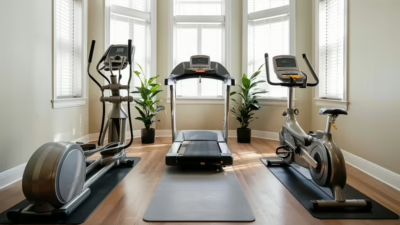Cardio workouts come in many forms, giving you plenty of options to get your heart pumping. You'll find traditional exercises like running and jogging, which build endurance through steady movement, alongside low-impact alternatives such as swimming and cycling that are gentler on your joints. Walking serves as an excellent starting point for beginners, while high-intensity interval training (HIIT) offers a challenging option for those seeking intense workouts. Dance fitness classes add a fun, rhythmic element to cardio, and rowing provides a full-body workout with minimal strain. Whether you prefer indoor or outdoor settings, there's much more to discover about each unique cardio style.
Running and Jogging Basics

Running and jogging represent the most fundamental forms of cardio exercise. As you explore different types of cardio workouts, you'll find that these activities offer incredible flexibility regarding intensity and duration. Whether you're a beginner or an experienced athlete, you can easily adjust your pace to match your fitness goals.
When you're starting out, it's important to understand high-intensity vs low-intensity cardio patterns. You'll want to begin with a gentle jog, maintaining a pace where you can hold a conversation, and gradually work your way up to more challenging speeds. For cardio for fitness purposes, try alternating between walking and jogging intervals to build your endurance.
You'll need proper running shoes, comfortable clothing, and a safe route to get started. Focus on your form by keeping your head up, shoulders relaxed, and arms at roughly 90-degree angles. Your feet should land beneath your body, not ahead of it, and you'll want to maintain a steady breathing rhythm.
Remember to start with 10-15 minutes and gradually increase your time as your fitness improves.
Cycling for Cardiovascular Health

Every cyclist knows that cycling delivers a powerful cardiovascular workout without the high-impact stress of running. When you're looking for one of the best cardio exercises for heart health, cycling stands out as an excellent choice that you'll actually enjoy doing.
Not only does cycling improve cardiovascular endurance, but it also plays a crucial role in fueling athletic performance through proper nutrition and hydration. Whether you're pedaling outdoors or using a stationary bike, you're engaging major muscle groups while strengthening your heart and lungs.
You'll experience these sensations during a quality cycling session:
- The rhythmic motion of your legs pushing and pulling as you maintain a steady cadence
- The gentle resistance of wind against your face as you cruise down peaceful streets
- The satisfying burn in your quadriceps as you power up challenging hills
- The steady rise in your heart rate as you find your perfect pace
To get the most cardiovascular benefit, aim to cycle for at least 30 minutes at a moderate intensity, where you're breathing heavily but can still hold a conversation.
You'll find that cycling isn't just effective for heart health—it's also incredibly versatile, allowing you to adjust intensity based on your fitness level and goals.
Swimming Techniques and Benefits
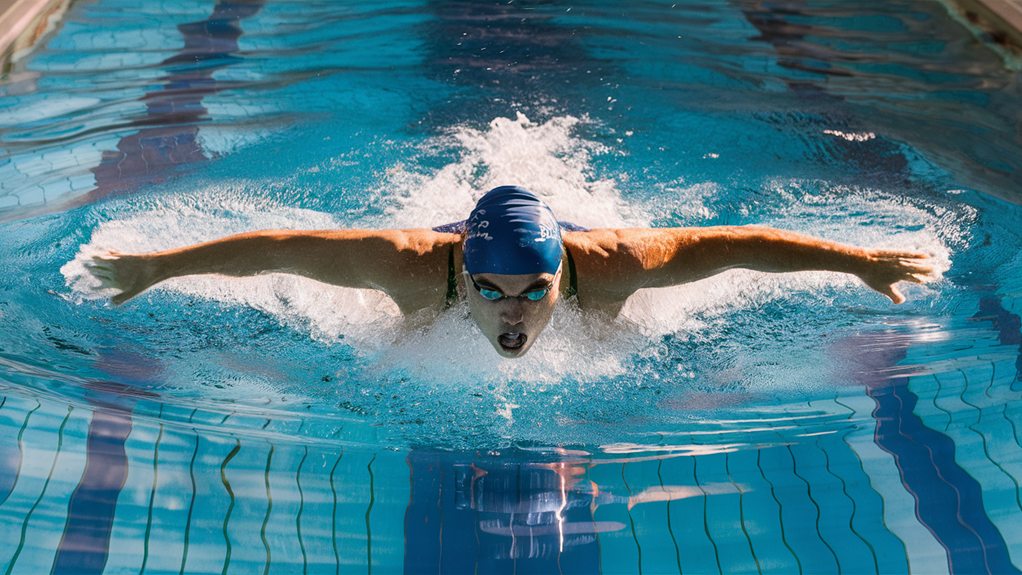
While many forms of cardio can strain your joints, swimming provides a full-body workout that's gentle on your body while maximizing cardiovascular benefits.
Unlocking weight loss through exercise can enhance your swimming experience, as it engages multiple muscle groups simultaneously, helping you burn calories and build endurance without putting stress on your bones and joints.
When you're in the pool, you've got several strokes to choose from, each offering unique benefits. The freestyle stroke, also known as the front crawl, is your go-to for building stamina and improving lung capacity. If you're looking to strengthen your back muscles, the backstroke's your best bet, and it's great for maintaining proper posture. The breaststroke, while slower, works wonders for your chest and shoulders, making it perfect for muscle definition.
You'll want to start with 20-30 minute sessions, focusing on proper form before increasing your duration.
Remember to breathe rhythmically, coordinating your breaths with your strokes. For beginners, it's helpful to break up your swim into intervals, allowing short rests between laps while you build your endurance.
Walking as Exercise
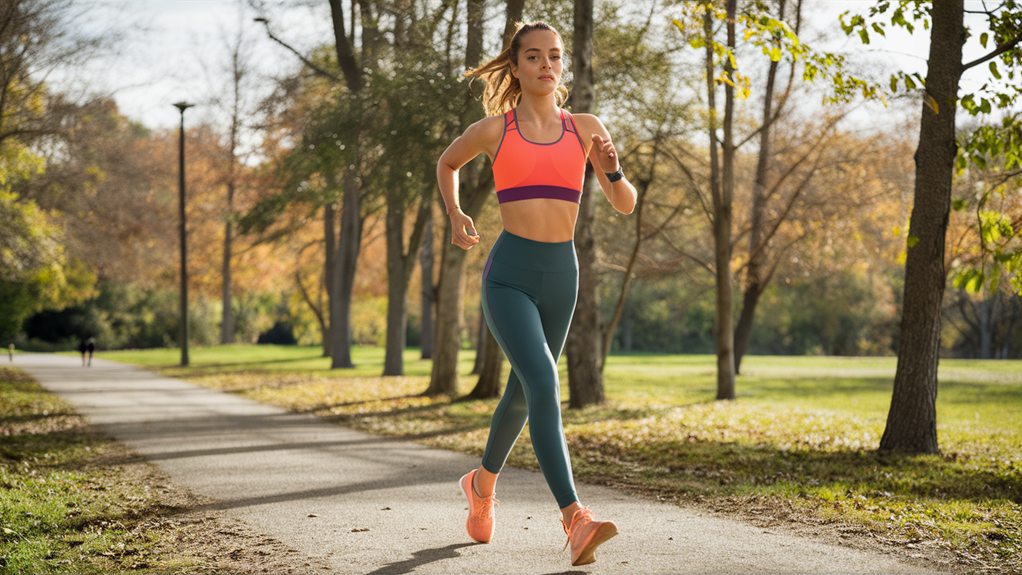
Taking daily walks might seem like a simple activity, but it's one of the most effective and accessible forms of cardio exercise available. You don't need special equipment or training to get started, and you can adjust your pace and duration to match your fitness level.
Additionally, walking can be easily adapted for various age groups, making it a great choice for families looking to engage in inclusive home workouts.
When you're walking for exercise, you'll want to maintain proper form by keeping your head up, shoulders relaxed, and arms swinging naturally at your sides. Start with 15-20 minute walks, and gradually increase your duration as your stamina improves.
To make your walks more engaging and effective, try these different walking styles:
- Power walking through your neighborhood with determined strides and pumping arms
- Nature walking on trails while observing the surrounding wildlife and scenery
- Interval walking by alternating between normal pace and brief speed bursts
- Urban walking while exploring new streets and architecture in your city
You'll know you're walking at the right intensity when you can still hold a conversation but feel slightly breathless. Aim to walk at least 30 minutes daily, and you'll boost your cardiovascular health, strengthen your muscles, and improve your mental well-being.
Indoor Vs Outdoor Training
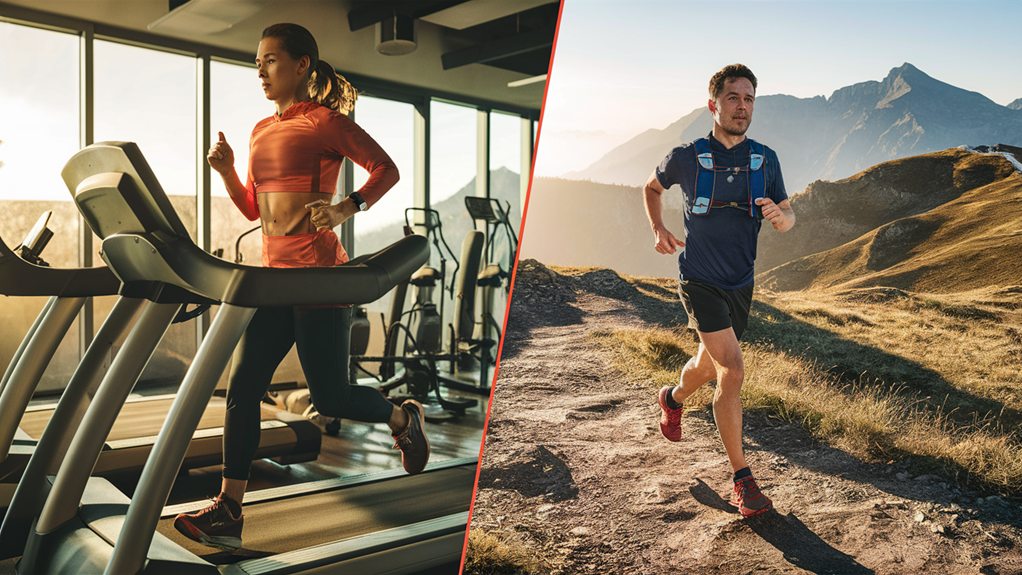
Deciding between indoor and outdoor cardio training isn't just about personal preference – each environment offers unique benefits and challenges for your workout routine. Cardiovascular exercise is essential for overall fitness, as it enhances heart health and boosts endurance, making your choice of training environment even more significant.
When you're exercising indoors, you'll have complete control over your environment, including temperature, weather conditions, and equipment availability. You won't need to worry about rain, extreme heat, or seasonal changes affecting your workout schedule.
Outdoor training, however, provides natural terrain variations that challenge your body in different ways, and you'll get the added benefits of fresh air and vitamin D from sunlight. Your muscles will work harder on uneven surfaces, and you'll burn more calories traversing hills and wind resistance.
You'll also enjoy the mental health benefits of being in nature, which can reduce stress and improve your mood. Additionally, engaging in regular outdoor cardio can lead to boosting your health with cardiovascular exercise benefits.
Consider mixing both types of training into your routine for the best results. You might choose to run outdoors on pleasant days but move your workout inside during extreme weather. This combination will help you maintain consistency in your fitness routine while enjoying the unique advantages of both environments.
HIIT Cardio Methods
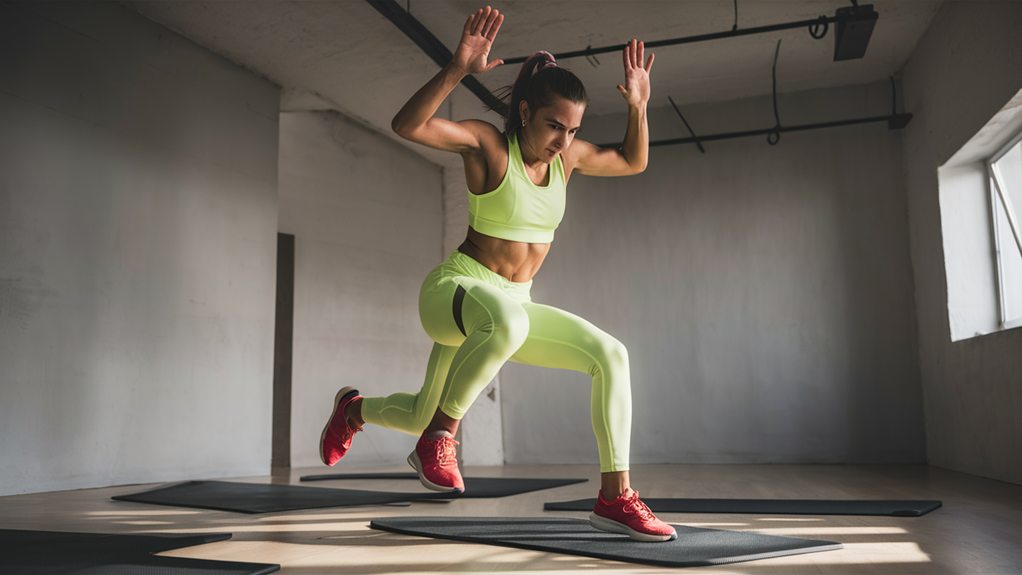
Your HIIT workout can include any combination of exercises, but here are some popular patterns you'll often see:
Incorporating equipment like kettlebells and rowing machines can further enhance the effectiveness of your HIIT sessions, allowing for a varied and challenging routine that targets multiple muscle groups maximize your gym workout.
- 30 seconds of explosive jumping jacks followed by 15 seconds of walking in place
- 45 seconds of high knees running followed by 20 seconds of light jogging
- 40 seconds of mountain climbers followed by 20 seconds of standing recovery
- 1 minute of burpees followed by 30 seconds of slow marching
You can structure your intervals based on your fitness level, starting with shorter work periods and longer rest periods.
As you get stronger, you'll want to increase your work intervals and decrease your rest time.
Remember to warm up properly and listen to your body, as HIIT's intensity requires proper form and recovery time.
Dance Fitness Fundamentals
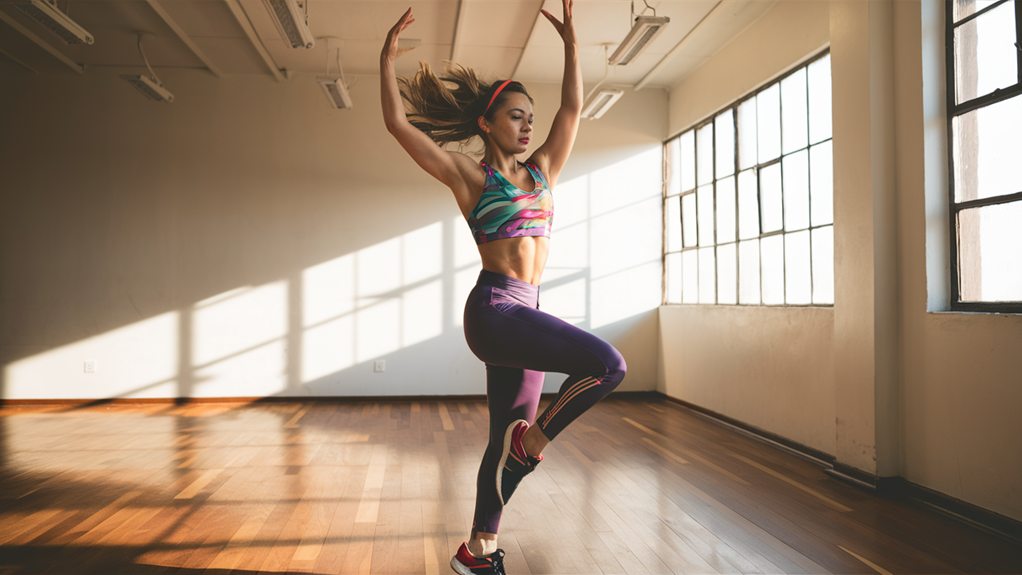
While HIIT focuses on structured intervals, dance fitness offers a more rhythmic approach to cardiovascular exercise. You'll find yourself moving to the beat while burning calories, improving coordination, and boosting your mood through energetic dance combinations.
Dance fitness brings together elements from various styles, including hip-hop, Latin dance, and contemporary movement, making it accessible for beginners and challenging for experienced dancers. These classes not only provide a fun way to get your heart rate up but also promote a sense of community among participants, as everyone shares in the joy of movement and expression through dance.
Many studios offer a variety of dance fitness options, showcasing different styles and intensities to cater to diverse preferences, which can enhance your overall fitness experience exploring diverse group classes.
When you're starting with dance fitness, you'll want to focus on mastering basic steps, like the grapevine, box step, and chassé, which form the foundation of most routines. Your instructor will typically break down combinations into smaller segments, allowing you to build confidence as you learn.
As you progress, you'll notice improvements in your balance, flexibility, and overall body awareness.
Most dance fitness classes run for 45-60 minutes, incorporating both low and high-impact movements that'll get your heart rate up. You don't need special equipment beyond supportive shoes and comfortable clothing, and you can modify movements to match your fitness level, making it an inclusive form of cardio exercise.
Rowing and Low Impact Exercise

Rowing machines provide one of the most complete full-body workouts while keeping impact on your joints minimal. When you're looking for an effective cardio exercise that won't stress your joints, rowing offers an excellent solution that engages multiple muscle groups simultaneously.
This type of workout not only aids in cardiovascular health but also supports muscle repair and energy production due to the involvement of various macronutrients. You'll find that proper form is essential, as it helps you maximize benefits while preventing strain on your back and shoulders.
During a rowing workout, you'll experience:
- The smooth gliding motion as your legs push against the footplates
- The controlled pull of the handle toward your chest as your back muscles engage
- The satisfying rhythm of each stroke as you coordinate your breathing
- The gentle whoosh of the flywheel as you maintain steady momentum
You can adjust the resistance to match your fitness level, making rowing an adaptable exercise for beginners and advanced athletes alike.
If you're new to rowing, start with shorter sessions of 10-15 minutes and focus on maintaining proper technique. As your endurance builds, you'll be able to extend your workouts while keeping the impact low and the benefits high.
Choosing the Right Workout
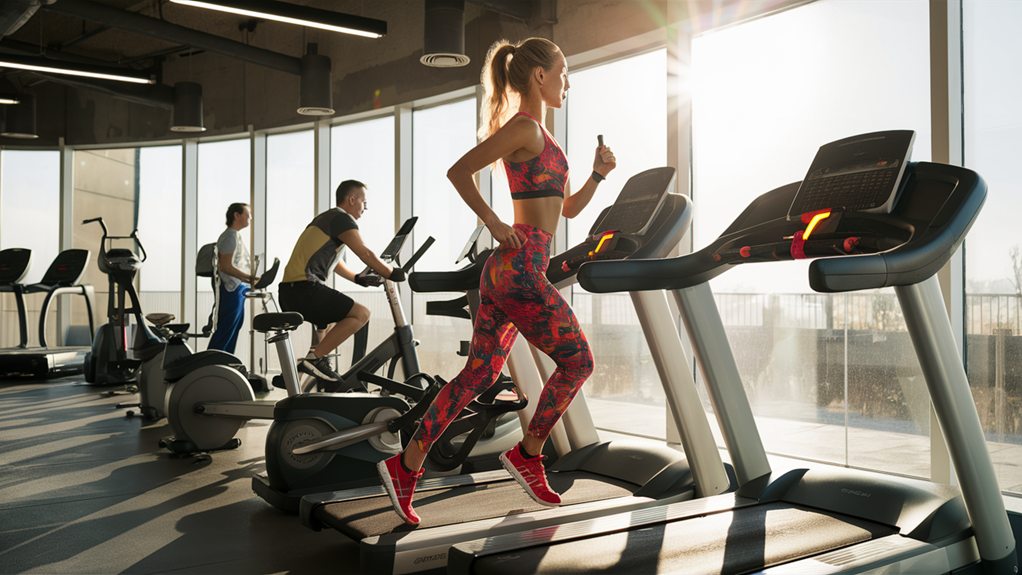
After understanding the benefits of low-impact exercises like rowing, selecting the most suitable cardio workout becomes the next important step.
You'll want to evaluate several key factors, including your current fitness level, any physical limitations, and your personal goals, before making your choice. Incorporating strength training can also enhance your cardio workouts by improving muscle mass and overall mobility, which is particularly beneficial as you age and work to maintain your independence strength training for seniors.
If you're new to exercise, you'll benefit from starting with walking, swimming, or using an elliptical machine, which are gentle on your joints and allow you to build endurance gradually.
For those with intermediate fitness levels, you might try cycling, jogging, or dance cardio classes, which can provide a more challenging workout while still being adaptable to your needs.
When you're dealing with joint issues or recovering from injury, stick to low-impact options like stationary cycling or water aerobics.
Evaluate your schedule and available resources, too. If you can't make it to a gym regularly, home-based exercises like jumping rope, bodyweight circuits, or online cardio classes might work better for you.
Remember that the best workout is one you'll actually stick to, so choose activities you enjoy and that fit naturally into your lifestyle.
Equipment and Space Requirements
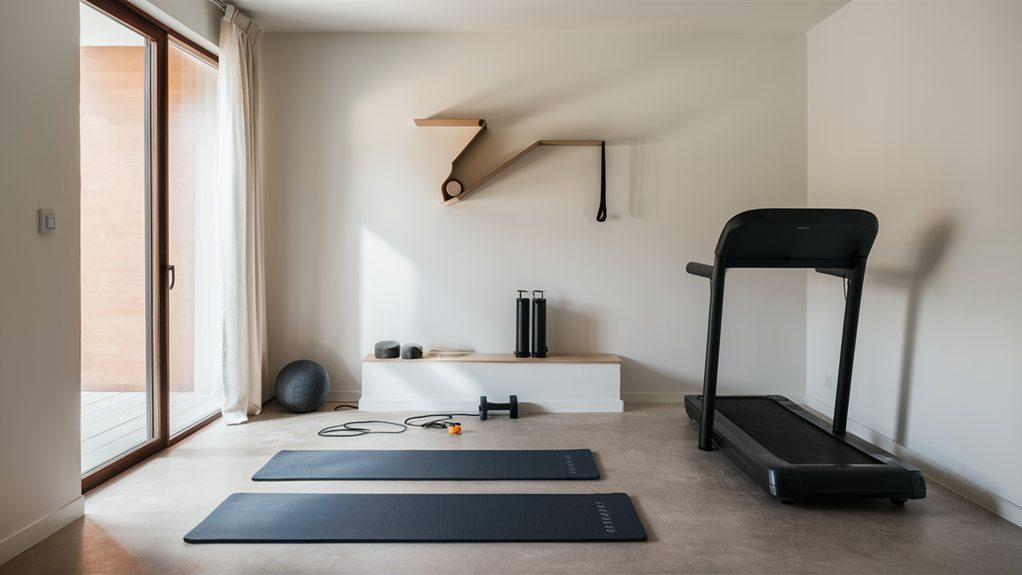
Setting up your cardio workout space depends largely on your chosen exercise type and available area.
You'll need to take into account both the equipment requirements and the amount of space you'll need to move freely and safely during your workout.
For home-based cardio, you can create an effective workout area with minimal equipment and space.
Whether you're planning to do jumping jacks in your living room or run on a treadmill in your basement, make sure you've got enough clearance for full range of motion.
You'll want to measure your space and compare it to these typical requirements:
- A yoga mat-sized area (6' x 2') for bodyweight exercises like mountain climbers and burpees
- An 8' x 4' space for equipment like ellipticals, stationary bikes, or rowing machines
- A 10' x 6' area for activities requiring lateral movement, such as jumping rope or dance cardio
- A 6' x 6' space minimum for step aerobics or other stepping exercises
Keep in mind that you'll also need proper ventilation, good lighting, and ideally a non-slip floor surface.
If you're using electronic equipment, make sure you've got access to power outlets and enough space for proper cord management.



